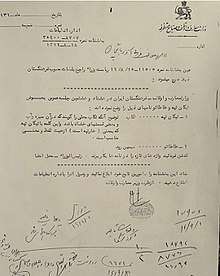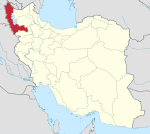Takab
| Takab تكاب، تیکان تپه | |
|---|---|
| City | |
 | |
 Takab | |
| Coordinates: 36°24′03″N 47°06′48″E / 36.40083°N 47.11333°ECoordinates: 36°24′03″N 47°06′48″E / 36.40083°N 47.11333°E | |
| Country |
|
| Province | West Azerbaijan |
| County | Takab |
| Bakhsh | Central |
| Government | |
| • Governor (acting) | Iraj Saghafi[1] |
| Population (2016 Census) | |
| • Total | 49,677 [2] |
| Time zone | UTC+3:30 (IRST) |
| • Summer (DST) | UTC+4:30 (IRDT) |

Takab or Tekab (Persian: تكاب) also known as Tikan Tapa[3] is a city and capital of Takab County, West Azerbaijan Province, Iran. At the 2006 census, its population was 43,702, in 10,078 families.[4] The city's inhabitants are predominantly Iranian Azerbaijanis who speak the Azerbaijani language. The famous historical complex Takht-e Soleyman is situated to the North-East of the city. Takht-e-Soleyman was one of Takab's oldest Zoroastrian fire temples during the Sassanid Dynasty and had the name Azargoshnasp.[5] The Karaftu Cave is also situated in Takab near Saqqez.
Etymology
Shiz is the ancient name used during Persian Empire for Takab. Takab means one narrow water way in Persian language. Tak means one or alone and Ab means water. Takab was originally known as Tikan Təpə by its native Turkic Afshar people until 1941 when Iran's Academy of Persian Language and Literature officially changed it to Takab. Afshar people are one of the Oghuz Turkic peoples.[6] These originally nomadic Oghuz tribes moved from Central Asia and initially settled in Iranian Azerbaijan, Azerbaijan republic, and Eastern Turkey. Later some of them were relocated by the Safavids to Khorasan and Mazandaran.[7] Today, they are variously grouped as a branch of the Turkmens[8] or the Azerbaijanis.[9]
People
The predominant language spoken in the city is Azerbaijani (most residents can speak Persian as well) and the predominant religion is Shia Islam.[10]
Culture
Takab has long been one of the centers for production of the famous Afshar rugs. Weaving in Takab flourished in the Safavid era.
Economy
The majority of residents of Takab earn their income from agriculture. Takab is home to the biggest gold mine in the entire country and one of the biggest in the Middle East.[11]
Notable people
- Shahriar Afshar: is an Iranian-American physicist and multiple award-winning inventor.
References
Notes
- ↑ Burns, Robert (October 8, 2016). "U.S.: Several Russian cruise missiles landed in Iran". Military Times. Archived from the original on January 24, 2017.
An earlier report by Fars on Wednesday quoted Iraj Saghafi, acting governor of Takab in northwestern Iran, saying an explosion heard in the region was "possibly related to work in a nearby rock quarry."
- ↑ https://www.amar.org.ir/english
- ↑ Takab can be found at GEOnet Names Server, at this link, by opening the Advanced Search box, entering "-3086724" in the "Unique Feature Id" form, and clicking on "Search Database".
- ↑ "Census of the Islamic Republic of Iran, 1385 (2006)". Islamic Republic of Iran. Archived from the original (Excel) on 2011-11-11.
- ↑ Mohammadi,A (1997). History of Takab Afshar. Tehran: Eman press, Khorshidi: 1376.
- ↑ Oberling, P. "AFŠĀR". Encyclopedia Iranica. Archived from the original on 2011-04-29. Retrieved 9 July 2009.
AFŠĀR, one of the twenty-four original Ḡuz Turkic tribes
- ↑ Iran's Diverse Peoples: A Reference Sourcebook, ed. Massoume Price, (ABC-CLIO, 2005), pp. 75, 89.
- ↑ From multilingual empire to contested modern state, Touraj Atabaki, Iran in the 21st Century: Politics, Economics & Conflict, ed. Homa Katouzian, Hossein Shahidi, (Routledge, 2008), 41.
- ↑ Richard V. Weekes. Muslim peoples: a world ethnographic survey. AZERI. — Greenwood Press, 1978 — p. 56 — ISBN 9780837198804
- ↑ https://web.archive.org/web/20081005202202/http://www.takhte-soleiman.com/TakabHistory.aspx
- ↑ http://www.farsnews.com/newstext.php?nn=8901181434
